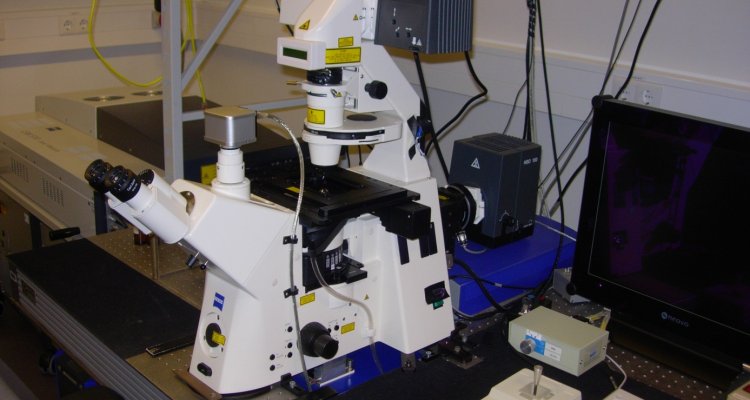
Equipment
Zeiss LSM 510-META Confocal laser scanning microscope
A traditional point scanning confocal laser scanning microscope (CLSM) with excitation from 405 to 633 and multichannel imaging. The system provides high resolution images of fluorescent molecules with improved signal noise ratio compared to wide field fluorescence microscopy. It offers options to localize specific biomolecules, analyse FRAP, quantify relative signal intensities, make time and z-series, and do 3-4D life cell imaging microscopy.
An additional series of detectors (the META channel) allows fluorescent emission fingerprinting to detect the full spectra of multiple fluorophores simultaneously, and discriminate various fluorescent molecules with overlapping spectra, thus excluding signal bleed through (autofluorescence from specific signals).
Optical tweezers are integrated on the CLSM and allow displacements and non-invasive manipulation of trapped refractive organelles or beads (0.5-5 μm), with simultaneous fluorescent imaging. An infrared (IR) Yag laser beam (1064 nm 3000mW) is used for optical trapping. Control over the laser power, selecting up to 10 (time shared) trap position(s) and adjustment of z-focus of the IR laser beam is obtained with the user-friendly MMI Position Tools software. It provides a tool for force applications on the micro scale. Quadrant Photo Detectors (QPDs) on a vibration free table are connected at the left side port and allow accurate position detection and force calibration.
Information obtained by light microscopy
- Localisation: Specific staining or fluorescent labels allow temporal and spatial localisation of your (bio)molecule of interest. A range of fluorescent probes can be combined for simultaneous multicolor, multidimensional image acquisition.
- Morphology and 3D reconstruction: The shape, 3D volume and interaction of molecules, organelles or tissues can be derived from optical sections from confocal microscopy.
- Analysing (sub)micron dynamics: Rapid image acquisition of fluorescent probes allows imaging (relative) dynamics that can be analysed in kymographs. Fluorescence recovery after photpbleaching (FRAP) studies give insight in fluorescent displacements and allow quantification of protein dynamics.
- Polarization microscopy: Biopolymers are made out of molecules arranged in a specific order and as a consequence have a birefringent characteristic. Protein crystals, collagen, cell wall polymers, microtubules or actin filament bundles are examples. Crystallographic and polymer orientation information can be obtained.
Technical details
- This Zeiss LSM 510-META 18 confocal laser scanning microscope consists of an Axiovert 200M equipped with Differential Interference Contrast (DIC) and with a range of excitation laser lines
- Ar diode laser: 405 nm (30 mW)
- Ar: 458, 477, 488, 514 nm (30 mW)
- HeNe: 543 nm (1mW)
- HeNe: 633 nm (5 mW)
- Objectives on Axiovert 200M equipped with DIC:
| N | NA | Objective | d (in mm) | Brand |
|---|---|---|---|---|
| 100x | 1.45 | α - Plan Fluar | 0.11 | Zeiss |
| 63x | 1.4 | Plan-Apochromat | 0.19 | Zeiss |
| 40x | 1.3 | Plan-Neofluar | 0.2 | Zeiss |
| 20x | 0.5 | Plan-Neofluar | 2 | Zeiss |
| 10x | 0.3 | Plan-Neofluar | 5.5 | Zeiss |
Applications
Application areas are in structural analysis, protein interactions, signal transduction, life sciences, single molecule detection, biochip development, food processing, biophysical studies and colloid chemistry.
Ancillary equipment
Ancillary equipment for sample preparation includes (cryo-)microtomes, micro slicer, needle puller, micro manipulation and microinjection.
In addition to the Confocal Laser Scanning microscopy, Wageningen University & Research, Shared Research Facilities offers the use of: